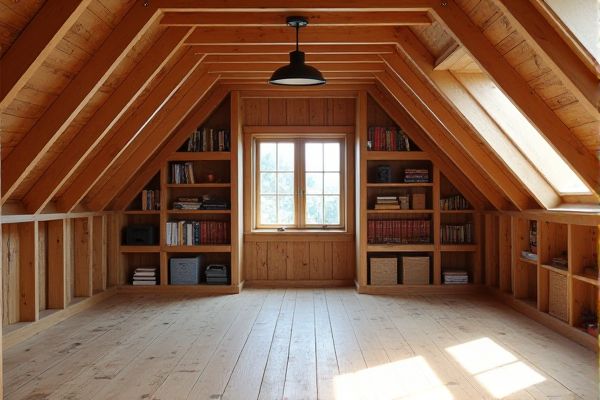
Open shelving in attics offers easy access and visibility, making it ideal for frequently used items, while closed shelving protects belongings from dust and pests, ensuring long-term preservation. Discover which storage solution best suits your attic needs by reading the rest of the article.
Table of Comparison
| Feature | Open Shelving | Closed Shelving (Attic) |
|---|---|---|
| Accessibility | Easy, quick access | Limited, requires effort |
| Visibility | Items fully visible | Items hidden |
| Dust Protection | Low, exposed items | High, enclosed space |
| Space Utilization | Maximizes display space | Maximizes storage space |
| Security | Low, open access | High, restricted area |
| Maintenance | Frequent dusting required | Less frequent cleaning |
| Best Use Cases | Display, easy reach items | Seasonal, rarely used items |
Introduction to Attic Storage Solutions
Attic storage solutions offer versatile options, with open shelving providing easy access and visibility for frequently used items, while closed shelving enhances protection against dust and pests. Choosing between open and closed shelving depends on your specific storage needs, such as maximizing space efficiency or safeguarding delicate belongings. Properly designed attic shelving can transform underutilized spaces into organized, functional storage areas tailored to your lifestyle.
Understanding Open Shelving in Attics
Open shelving in attics offers easy access and visibility for storage, making it an efficient solution for organizing seasonal items and tools. Unlike closed shelving, it maximizes airflow and reduces the risk of mold and moisture buildup, which is crucial in attic spaces that often experience temperature fluctuations. Installing sturdy, moisture-resistant materials for open shelves enhances durability and ensures long-term usability in attic environments.
Benefits of Open Shelving for Attic Organization
Open shelving in attic organization maximizes visibility and accessibility, making it easier to locate and retrieve stored items quickly. Its design promotes better air circulation, reducing moisture buildup and potential mold damage in attic spaces. Open shelves also offer flexible storage options for irregularly shaped items, enhancing overall attic functionality and space utilization.
Drawbacks of Open Shelving in Attic Spaces
Open shelving in attic spaces often leads to increased dust accumulation and limited protection against pests or humidity, which can damage stored items. The lack of enclosed barriers compromises insulation and reduces energy efficiency, making temperature and moisture control more challenging. Structural limitations in attics may also restrict shelf weight capacity and organization options compared to closed shelving systems.
Overview of Closed Shelving for Attics
Closed shelving in attics offers superior protection against dust, pests, and temperature fluctuations, preserving your stored items more effectively than open shelving. These enclosed storage units maximize space utilization by providing organized compartments, reducing clutter while maintaining easy access to seasonal belongings. Choosing closed shelving can enhance the overall cleanliness and safety of your attic, ensuring your valuables remain intact and well-maintained over time.
Advantages of Closed Shelving Systems
Closed shelving systems in attics provide superior protection against dust, moisture, and pests, preserving the condition of your stored items. These enclosed storage solutions enhance organization by concealing clutter and maximizing vertical space with adjustable shelves. You benefit from increased security and aesthetic appeal, creating a cleaner and more efficient attic environment.
Disadvantages of Closed Shelving in Attic Storage
Closed shelving in attic storage often limits visibility and accessibility, making it difficult to quickly locate your stored items. The enclosed design can trap dust and moisture, increasing the risk of damage to sensitive belongings. Limited airflow in closed shelving may also contribute to poor ventilation, potentially leading to mold or mildew buildup over time.
Key Factors to Consider: Open vs Closed Shelving
Open shelving offers easy access and visibility, ideal for frequently used items and decorative displays, while closed shelving in attics provides protection from dust, moisture, and temperature fluctuations, essential for preserving seasonal or sensitive belongings. Consider space utilization, airflow, and potential pest exposure when choosing between open and closed shelving to maximize storage efficiency and item longevity. Evaluate the attic's insulation and ventilation since closed shelving can help regulate conditions, whereas open shelving promotes better air circulation but may expose stored goods to environmental elements.
Design Tips for Optimizing Attic Shelving
Open shelving in the attic maximizes visibility and accessibility, making it easier to organize and locate items quickly, while closed shelving protects belongings from dust and temperature fluctuations. Use adjustable shelves and clear storage bins to maintain a clean, customizable space that adapts to your changing storage needs. Your attic can be optimized by balancing open and closed options, ensuring efficient use of limited space while preserving aesthetic appeal.
Conclusion: Choosing the Right Shelving for Your Attic
Selecting the right attic shelving depends on your storage needs and space aesthetics; open shelving offers easy access and visibility, ideal for frequently used items, while closed shelving provides protection from dust and a cleaner look for long-term storage. Consider the attic's climate and item sensitivity--closed shelving can safeguard belongings from temperature fluctuations and pests. Ultimately, balancing functionality with design preferences ensures efficient and organized attic storage tailored to your lifestyle.
 homyna.com
homyna.com